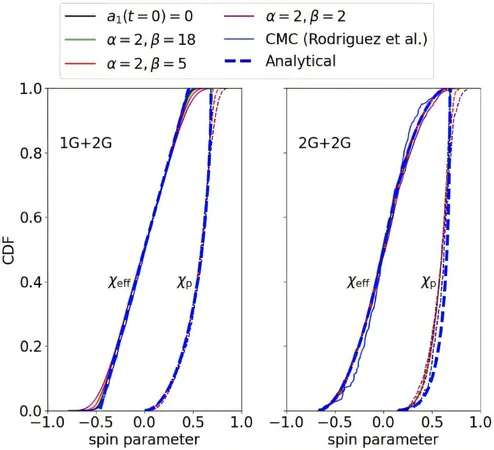
Unlocking the Secrets of Black Holes: New Insights into Their Formation Through Spin and Gravitational Waves
2025-01-07
Author: Daniel
Introduction
In a groundbreaking study, researchers from Cardiff University have unveiled that the spin and size of black holes provide crucial insights into their formation. This research, published in the reputable journal *Physical Review Letters*, suggests that many observed black holes have undergone multiple mergers within crowded environments teeming with millions of stars.
Research Methodology
The team meticulously analyzed a public catalogue comprising 69 gravitational wave events, specifically focusing on binary black holes detected by the esteemed Laser Interferometer Gravitational-Wave Observatory (LIGO) and Virgo Observatory. Their critical examination revealed that the spin of a black hole experiences a significant shift as it reaches a specific mass threshold, indicating that these cosmic giants may have formed via recurrent mergers.
Key Findings
Lead author Dr. Fabio Antonini emphasized the diversity of black holes' masses and spins observed through gravitational wave detectors. He stated, “As we observe more black hole mergers, it becomes increasingly evident that they originate from various formation pathways. However, pinpointing the dominant formation scenarios has posed a considerable challenge.”
Mass Threshold Discovery
The research uncovered a distinctive mass threshold in the gravitational wave data where black hole spins consistently shifted. Remarkably, this finding aligns with existing models theorizing that black holes are often produced through successive collisions within dense star clusters, in stark contrast to other environments which yield different spin distributions.
Implications of the Research
Co-author Dr. Isobel Romero-Shaw, a postdoctoral researcher at the University of Cambridge, noted that this study offers a robust, data-driven method to trace the evolutionary history of black holes. She stated, “Our findings suggest that a black hole’s spin serves as a powerful indicator of its origins, particularly highlighting high-mass black holes forming in star clusters where smaller black holes continually collide and merge.”
Future Outlook
As this research progresses, it holds the potential to refine computer simulations illustrating black hole formation, paving the way for enhanced interpretations of future gravitational wave detections. The implications of these findings extend far beyond just understanding black holes; they also contribute significantly to the broader foundations of astrophysics and our comprehension of the universe’s intricate dynamics.
Conclusion
With more black hole mergers on the horizon due to advancing detection technologies, the cosmos continues to surprise us, unlocking age-old mysteries and challenging our understanding of gravitational phenomena. Stay tuned as we unravel the enigma of black holes, one spin at a time!


 Brasil (PT)
Brasil (PT)
 Canada (EN)
Canada (EN)
 Chile (ES)
Chile (ES)
 Česko (CS)
Česko (CS)
 대한민국 (KO)
대한민국 (KO)
 España (ES)
España (ES)
 France (FR)
France (FR)
 Hong Kong (EN)
Hong Kong (EN)
 Italia (IT)
Italia (IT)
 日本 (JA)
日本 (JA)
 Magyarország (HU)
Magyarország (HU)
 Norge (NO)
Norge (NO)
 Polska (PL)
Polska (PL)
 Schweiz (DE)
Schweiz (DE)
 Singapore (EN)
Singapore (EN)
 Sverige (SV)
Sverige (SV)
 Suomi (FI)
Suomi (FI)
 Türkiye (TR)
Türkiye (TR)
 الإمارات العربية المتحدة (AR)
الإمارات العربية المتحدة (AR)